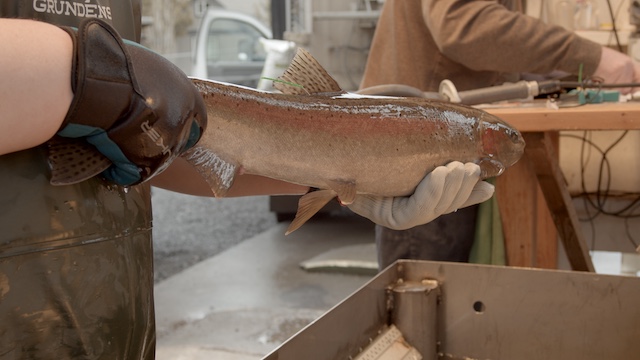Record steelhead return in Upper Deschutes
Published 2:24 pm Wednesday, April 9, 2025

- An adult steelhead is handled at the Pelton Round Butte Dam complex, where young fish travel downstream before returning as adults after spending years in the open ocean. (Submitted photo)
Improved ocean conditions and local ecosystem work have set the stage for a record number of adult steelhead returning to the Upper Deschutes River.
During the 2024-2025 steelhead run, over 950 fish passed upstream of the Pelton Round Butte Dam Complex — six times the amount that passed through the complex in recent runs. More steelhead are in the Upper Deschutes now than at any time since the 1960s.
Drew Hanson, a spokesperson for Portland General Electric — which co-owns the dams with the Confederated Tribes of the Warm Springs — says favorable ocean conditions including water temperature, food availability and other factors have helped steelhead return. But he says local efforts are also paying off.
Trending
“The last decent steelhead run in the lower Deschutes was in 2014, and we didn’t see this level of steelhead returning to the upper basin population,” said Hanson. “This indicates to us that management changes at the Pelton Round Butte project are also playing an important role in the results.”
Selective water withdrawal tower
Increasing the steelhead population above the Pelton Round Butte Complex has been a goal for dam managers for decades. Portland General Electric and the Tribes spent over $100 million for a so-called selective water withdrawal tower in Lake Billy Chinook.
The tower, completed in 2009, collects young fish as they head downstream. It also blends water from the reservoir for the Lower Deschutes River to replicate natural water conditions.
Of the 961 adult steelhead that passed upstream, 676 were reared at hatcheries and released as smolts — young fish — in Crooked and Deschutes subbasins for reintroduction. Another 279 fish were Round Butte Hatchery fish released into the Crooked River as part of a pilot study. Most of the introduction work was carried out in 2022.
Six were natural-origin or wild fish. Scientists can distinguish between hatchery and natural fish because fish managers typically clip the adipose fin before releasing hatchery stock. Fish heading down the Deschutes are marked with a maxillary clip — near the mouth — for identification.
Most fish spend about two years at sea before making a 300-mile journey back to the Upper Deschutes River.
Year-over-year improvements
Trending
The number of steelhead to return to the Round Butte Complex this run dwarfs the total of previous years. The 2023-2024 run saw a return of 168 steelhead, while the 2022-2023 run saw a return of 130 steelhead. The four previous years were even lower, ranging from 36 to 46.
“The sixfold increase in returns (from a year ago) is reflective of the stronger run in general and improved feeding conditions in the Columbia River Estuary and Pacific Ocean,” said Jerry George, a fish biologist with the Oregon Department of Fish and Wildlife.
The positive results at the Pelton Round Butte dam complex mirror the strong summer steelhead run for the Columbia River above Bonneville Dam. But while the run exceeded forecasts and was the best in a decade, it was still lower than steelhead runs for the 2005-2015 period, according to George.
“For perspective, the 2024 run was only 74% of the 20-year average for the Columbia River above Bonneville,” said George.
Local challenges
George adds that reintroducing salmon and steelhead into their historic habitat above the Pelton Round Butte Dam complex during a period of poor returns to the Columbia Basin has been “extremely challenging.”
“The fish that return for reintroduction in the Upper Deschutes face additional challenges, including collection at the Pelton Trap, handling, and transport, navigating Lake Billy Chinook and finding suitable spawning habitat and mates in tributaries,” George said.
While improving ocean conditions are largely credited for the increased numbers, George says local reintroduction efforts have also improved conditions for fish. These include habitat restoration, an improved diet for hatchery smolts and acclimating fish in tributaries before their release. Releasing smolts at dusk also appears to help their chances of survival.
But George says the low number of natural-origin or wild fish returning remains a concern.
“It illustrates that the reintroduction program still has a long way to go to reach the ultimate goal of having a self-sustaining population,” he said. “In the future, we would like to see the numbers tip toward more wild fish returning than hatchery-origin fish but that will take time.”
Reporter: 541-617-7818, mkohn@bendbulletin.com








